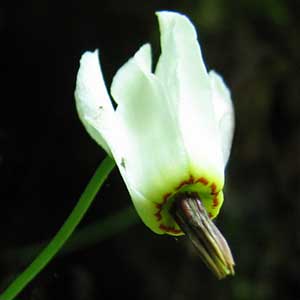Dodecatheon dentatum
Dodecatheon meadia
dentate shooting star, tooth American cowslip, white shooting star
pride-of-Ohio
not obvious at anthesis, or sometimes erect to slightly horizontal, slender;
roots white or reddish;
bulblets absent.
not obvious at anthesis;
roots whitish to tan or brownish;
bulblets absent.
(3.5–)8–20(–30) × (1–)2.5–6(–7) cm;
petiole slightly winged;
blade ovate, base decurrent onto stem, abruptly tapering to petiole, margins subentire to sinuate or crenate, surfaces glabrous.
8–30 × 2–8 cm;
petiole winged;
blade (usually suffused with red at base even when dry), usually oblanceolate to oblong or spatulate, rarely ovate, base decurrent onto stem, gradually tapering to petiole, margins usually entire, rarely coarsely toothed, surfaces glabrous.
(1–)2–5(–11)-flowered;
bracts lanceolate, 1.5–5(–8) mm, glabrous.
1–25(–125)-flowered;
bracts lanceolate, 3–10 mm, usually glabrous, rarely glandular-pubescent.
0.8–5 cm, glabrous.
(1.5–)3–7 cm, usually glabrous, rarely glandular-pubescent.
calyx light green, 4–6 mm, glabrous, tube 2–3.5 mm, lobes 5, 1.5–3(–4) mm;
corolla tube yellow with red, thin, wavy ring, lobes 5, white, 7–18(–20) mm;
filaments distinct, maroon to black, 0.1–0.5 mm;
anthers (4.5–)5–7.5 mm;
pollen sacs maroon to black, connective dark purple to maroon, smooth;
stigma not enlarged compared to style.
calyx light green to green, 5–12 mm, glabrous, tube 2–3.8 mm, lobes 5, (2.5–)3–7(–9) mm;
corolla tube maroon and yellow with dark maroon, ± thick, wavy ring, lobes 5, white or lavender to magenta, (10–)12–25(–27) mm;
filaments usually connate, tube yellow, 0.5–3 × 1–2 mm;
anthers (4–)5.5–10 mm;
pollen sacs yellow, sometimes speckled with red or maroon, connective purple, dark maroon, or black, smooth;
stigmas not enlarged compared to style.
pale greenish to tannish, dark yellow apically, valvate, narrowly ovoid, (6–)8–11 × 3–5 mm, glabrous;
walls thin, pliable.
dark reddish brown, valvate, cylindric-ovoid, 7–18(–21) × 4–6(–9) mm, glabrous;
walls thick, firm.
without membrane along edges.
without membrane along edges.
= 44.
= 88.
Dodecatheon dentatum
Dodecatheon meadia
Dodecatheon dentatum occurs mainly on the eastern slope of the Cascade Range from south-central British Columbia to central Washington, with disjunct populations near the Columbia River in southwestern Washington, the Columbia River Gorge, northeastern Oregon, and northern Idaho. In Idaho, this species occasionally forms hybrids with D. pulchellum var. pulchellum (Oberle 262, MO).
(Discussion copyrighted by Flora of North America; reprinted with permission.)
Dodecatheon meadia is widespread and highly variable. Many segregate species and infraspecific entities have been proposed. Except for recognizing D. frenchii (a diploid), partitioning D. meadia (a tetraploid) into finer units as done by N. C. Fassett (1944) is unrealistic. It has been traditional to distinguish at least two varieties. The typical variety is mainly a plant of the north and east with anthers 6.5–10 mm, capsules 10–18(–21) mm, calyx lobes 4–8 mm, and corolla lobes 12–20 mm. To the south and west (mainly Missouri, eastern Oklahoma, eastern Texas, and Arkansas to northwest Alabama, Tennessee, and Virginia) plants with anthers 4–7(–8) mm, capsules 7–10 mm, calyx lobes 3–5 mm, and corolla lobes 10–15 mm occur; these have been termed var. brachycarpum. A distinction is not made here because both entities are sometimes found growing together, and each can be found, often as individual plants, well outside its expected range. Flower color varies in a different pattern. Most of the southern populations of D. media have white petals; those of the north (including the Linnaean type) have lavender to magenta petals. Throughout the range, petals are sometimes more pinkish or are white with a tinge of purple. In southern Missouri and northern Arkansas are plants with alabaster white petals. All too often, a single population will vary in petal color, making a taxonomic distinction dubious. Plants with ovoid capsules 9–10 × 4–9 mm occur in Alabama; these were named var. obesum Fassett. Although the ovoid condition appears to be restricted geographically, it is doubtful that it diagnoses a well-marked variety.
Dodecatheon meadia is locally common in some areas; on its geographical edges, it is often rare and thus of local concern to some state heritage programs. The species is commonly cultivated and numerous cultivars have been developed.
(Discussion copyrighted by Flora of North America; reprinted with permission.)
